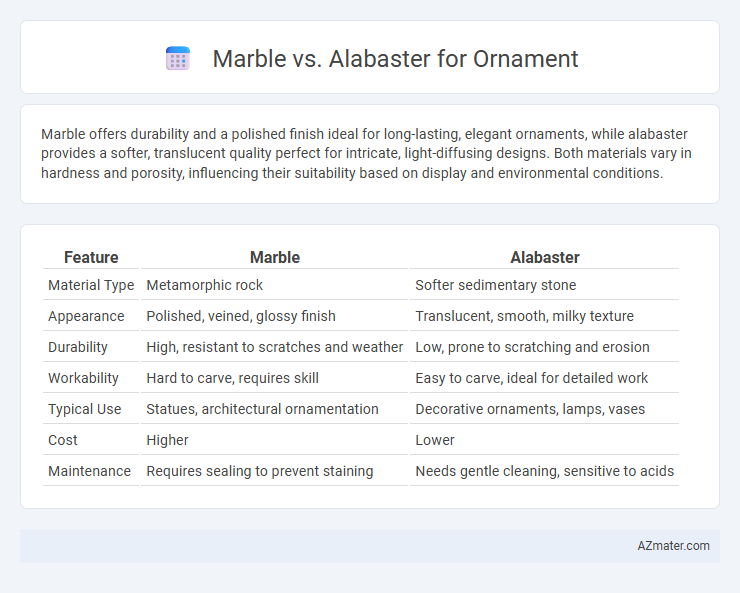Marble offers durability and a polished finish ideal for long-lasting, elegant ornaments, while alabaster provides a softer, translucent quality perfect for intricate, light-diffusing designs. Both materials vary in hardness and porosity, influencing their suitability based on display and environmental conditions.
Table of Comparison
| Feature | Marble | Alabaster |
|---|---|---|
| Material Type | Metamorphic rock | Softer sedimentary stone |
| Appearance | Polished, veined, glossy finish | Translucent, smooth, milky texture |
| Durability | High, resistant to scratches and weather | Low, prone to scratching and erosion |
| Workability | Hard to carve, requires skill | Easy to carve, ideal for detailed work |
| Typical Use | Statues, architectural ornamentation | Decorative ornaments, lamps, vases |
| Cost | Higher | Lower |
| Maintenance | Requires sealing to prevent staining | Needs gentle cleaning, sensitive to acids |
Introduction: Marble vs Alabaster for Ornaments
Marble and alabaster are both prized materials for ornamental sculptures due to their unique aesthetic qualities and workability. Marble is a metamorphic rock known for its durability, smooth texture, and wide range of color variations, making it ideal for detailed, long-lasting art pieces. Alabaster, a softer sedimentary stone, offers a translucent, warm glow that enhances fine carving details, but it requires careful handling due to its susceptibility to scratching and moisture damage.
Overview of Marble and Alabaster Materials
Marble is a dense, metamorphic rock composed primarily of recrystallized carbonate minerals, known for its durability, wide range of colors, and polished finish, making it ideal for high-end ornamental sculptures and architectural details. Alabaster is a soft, translucent sedimentary mineral, often made of gypsum or calcite, prized for its smooth texture and warm, luminous glow that highlights fine carving and intricate designs in decorative objects. Both materials offer distinct aesthetic qualities and workability, with marble favored for strength and longevity, while alabaster is preferred for delicate, light-enhanced ornamentation.
Aesthetic Differences: Marble vs Alabaster
Marble displays a glossy, translucent surface with intricate veining patterns, providing a luxurious and timeless aesthetic ideal for high-end ornaments. Alabaster offers a softer, matte finish with a creamy, translucent quality that diffuses light gently, creating a warm, glowing effect in decorative pieces. The choice between marble and alabaster hinges on the desired visual impact, with marble emphasizing elegance and durability, while alabaster highlights subtlety and light diffusion.
Durability and Longevity Comparison
Marble offers superior durability for ornaments due to its high hardness and resistance to scratching and weathering, making it ideal for both indoor and outdoor displays. Alabaster, while prized for its translucent beauty, is significantly softer and more susceptible to chipping, scratching, and moisture damage, limiting its longevity primarily to indoor use. Over time, marble maintains structural integrity and aesthetic appeal better than alabaster, ensuring lasting ornamental value.
Carvability and Artistic Detailing
Marble offers superior durability and a polished finish, making it ideal for intricate artistic detailing and long-lasting ornaments. Alabaster, with its softer texture and translucent quality, allows for easier carving and fine, delicate features but is more prone to chipping. Artists often choose marble for detailed sculptures requiring strength, while alabaster is preferred for ornaments emphasizing subtle, intricate designs and smooth carvability.
Weight and Handling Considerations
Marble is significantly denser and heavier than alabaster, making marble ornaments more durable but challenging to handle and transport. Alabaster is much lighter and softer, allowing for easier carving and manipulation, ideal for intricate designs and handheld pieces. Choosing between marble and alabaster depends on balancing weight for stability against the ease of handling during crafting and display.
Maintenance and Care Requirements
Marble requires regular sealing to protect against stains and etching due to its porous nature, and it benefits from gentle cleaning with pH-neutral cleaners to maintain its polished surface. Alabaster is softer and more porous, needing careful dusting and avoidance of water and acidic substances to prevent damage or discoloration. Both materials demand careful handling and specific cleaning routines to preserve their ornamental beauty over time.
Cost Analysis: Marble vs Alabaster
Marble costs significantly more than alabaster due to its durability, rarity, and labor-intensive extraction process, with prices averaging $50 to $150 per square foot compared to alabaster's $10 to $40 range. Alabaster offers a budget-friendly option for ornamental materials but sacrifices some structural strength and longevity that marble provides. Cost analysis should factor in maintenance expenses, as marble's hardness reduces wear, while alabaster's softness may lead to higher upkeep over time.
Suitable Applications and Design Styles
Marble's durability and polished finish make it ideal for intricate sculptures, countertops, and modern or classical design styles emphasizing elegance and luxury. Alabaster, with its soft texture and translucency, suits delicate decorative objects, light fixtures, and artistic pieces in traditional, rustic, or Mediterranean interiors. Both stones complement different aesthetic purposes, with marble favored for structural strength and alabaster for subtle, warm illumination effects.
Choosing the Right Material for Your Ornament
Marble offers exceptional durability and a polished finish, making it ideal for high-end ornaments that require toughness and longevity. Alabaster, with its translucent quality and softer texture, suits intricate designs and delicate decorations but demands careful handling due to its fragility. Selecting between marble and alabaster depends on balancing the desired aesthetic impact with the ornament's intended use and environmental exposure.

Infographic: Marble vs Alabaster for Ornament
 azmater.com
azmater.com